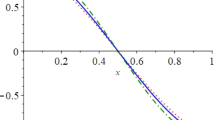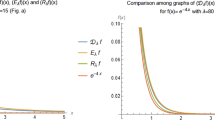Abstract
In this paper, we give a generalization of the Baskakov-type operators introduced by Baskakov (Doklady Akademii Nauk SSSR 113:249–251, 1957 (in Russian)) and obtain some direct and inverse results for these new operators.
MSC
41A35, 41A36
Similar content being viewed by others
Avoid common mistakes on your manuscript.
Introduction
For a continuous function f on [0,∞) with exponential growth, the Szász operators are given by
where . In [1], Ditzian proved some important inverse theorems for these operators by using the modulus of continuity defined by
where supx∈[0,∞)| f(x)e-Ax| < M.
In 1992, Guo and Zhou [2] gave similar theorems for the following modified Szász operators defined by Mazhar and Totik in [3]:
The authors obtained the following results for these operators:
-
(1)
Let f ∈ C[0,∞) be a bounded function. Then, for 0 < α < 1,
holds if and only if
where
-
(2)
For f ∈ C[0,∞)∩L ∞ [0,∞) and 0 < α < 1,
holds, where ω1(f;δ) is defined by (2) and
-
(3)
For f∈C B [0,∞),
holds, where C is a constant independent of n, and is the Ditzian-Totik modulus of smoothness [4] defined by
In [5], Baskakov introduced the following sequence of linear operators which are generalizations of Bernstein polynomials, Szász operators, and Lupas operators:
Here, , b can be ∞), , and is a sequence of functions defined on [0,b] that have the following properties for all
-
(a)
φ n is analytic on the interval [0,b] including the end points,
-
(b)
φ n (0) = 1,
-
(c)
φ n is completely monotone, i.e. ,
-
(d)
there exists a positive integer m 0 = m 0(n), such that
-
(e)
.
For the operators given by (4), we have (see [5]):
and
In the present paper, inspired by the operators (1) and (4), we introduce a generalization of the Baskakov operators as follows:
where for all and φ n also satisfies the following condition:
and
In this study, we shall give some direct and inverse results for the new operators defined by (8).
Note that if φ n (x) = e-nxin (8), we get the operators L n (f;x) defined by (1). Also, very important results were obtained by Mazhar and Totik in [3]. Recently, integral-type modification of some operators based on q-integers have been studied by Gupta et al. [6], Gupta and Kim [7], and Kim [8].
Main results
Now, we give the following lemma which will be used for the proof of theorems:
Lemma 1. The following equalities hold:
From the definition of operators and Lemma 1, we have
Theorem 2. Let f ∈ C[0,∞)be a bounded function, and 0 < α ≤ 1.If the usual modulus of smoothness ω1(f,t)defined by (2) satisfies
then
holds.
Proof. Using the definition of the operators and the equality (9), we obtain the following inequality:
If we choose δ n as
then we get
Consequently, using (10) in the above inequality, we finally get
Theorem 3. Let f ∈ C[0,∞)be a bounded function, and 0 < α < 1.If
for some positive constant K,then
where ω1(f,t) is the usual modulus of smoothness of f defined by (2).
Proof. For δ > 0, let
For the function f ∈ C[0,∞) ∩ L ∞ [0,∞), the following inequalities hold (see [9]).
Now, we find the derivative of with respect to x. From the definition of the operators , we can write
Now, using the properties of the operators (4), we obtain
where we have used the inequality,
On the other hand, we also have
Using the two estimates of obtained above, we get
Also, one can easily obtain that
For any t > 0 and 0 < h ≤ t, t∈(0,∞), we can write
where
Note that for any , we have
Hence, for , we can choose such that
For sufficiently large n, we get
From last inequality, for 0 < h ≤ t, we get
which implies ω1(f;t) = O(tα), as desired. □
Theorem 4. For f ∈ C[0,∞) ∩ L ∞ [0,∞), 0 < α < 2, we have
where ω2(f,.)is the modulus of smoothness of f defined by (3).
Proof. (:⇒) We assume that ω2(f,t) ≤ M tα. For g ∈ C B [0,∞), we get the second-order derivative of the operator with respect to x as
Hence,
and
Now for f ∈ C[0,∞)∩L ∞ [0,∞), let us define the Steklov function as
Then,
and
For f d , one can verify
Choosing , we get
which proves the necessity part of the theorem. (⇐:) Now, in order to prove the sufficiency part of the theorem, we define the combination of as follows
where |a0(n)| + |a1(n)| ≤ B, n = n0 < n1 ≤ A n with A and B as absolute constants having the property
Using the methods in [9, 10] for f ∈ C[0,∞)∩L ∞ [0,∞), we have
For m,n ∈ N, x ∈ (0, ∞ ),0 < h ≤ t, we have
Now, we shall estimate the second term on the right-hand side of the above inequality. Firstly, we have
On the other hand, we also have
From which, we can write
Hence, using the above inequality, we get
After making some arrangements and then taking the integral of both sides of the above inequality, we get
Now, substituting (15) into (14), we finally obtain
where . Choosing such that
we obtain from (16) by induction
If we take C = (1 + 4M)1/α and let k → ∞, we obtain
which implies that ω2(f,t) = O(tα), where is independent of m. So, the proof is completed. □
References
Ditzian Z: On global inverse theorems of Szász and Baskakov operators. Can. J. Math 1979,31(2):255–263. 10.4153/CJM-1979-027-2
Guo Z-R, Zhou D-X: Approximation theorems for modified Szász operators. Acta Sci. Math 1992, 56: 311–321.
Mazhar SM, Totik V: Approximation by modified Szász operators. Acta Sci. Math 1985, 49: 257–269.
Ditzian Z, Totik V: Moduli of Smoothness. Berlin: Springer; 1987.
Baskakov VA: An example of a sequence of linear positive operators in the space of continuous functions. Doklady Akademii Nauk SSSR 1957, 113: 249–251. in Russian in Russian
Gupta V, Sharma H, Kim T, Lee S-H: Properties of q-analogue of Beta operator. Adv. Difference Equ 2012, 86: 16.
Gupta V, Kim T: On the rate of approximation by q modified beta operators. J. Math. Anal. Appl 2011,377(2):471–480. 10.1016/j.jmaa.2010.11.021
Kim T: Some formulae for the q-Bernstein polynomials and q-deformed binomial distributions. J. Comput. Anal. Appl 2012,14(5):917–933.
Becker M, Nessel RJ: A global approximation theorem for Meyer-K öning and Zeller operators. Math. Z 1978, 160: 195–206. 10.1007/BF01237033
Becker M: Global approximation theorems for Szász-Mirakjan and Baskakov operators in polynomial weight space. Indiana Univ. Math. J 1978, 27: 127–141.
Acknowledgements
We would like to thank the referee for carefully reading the manuscript which contributed to its improvement.
Author information
Authors and Affiliations
Corresponding author
Additional information
Competing interests
The authors declare that they have no competing interests.
Authors’ contributions
ÇA, SKS, and İB equally contributed to the making of this paper. All authors read and approved the final manuscript.
Rights and permissions
Open Access This article is distributed under the terms of the Creative Commons Attribution 2.0 International License (https://creativecommons.org/licenses/by/2.0), which permits unrestricted use, distribution, and reproduction in any medium, provided the original work is properly cited.
About this article
Cite this article
Atakut, Ç., Serenbay, S.K. & Büyükyazici, İ. Approximation properties for generalized Baskakov-type operators. Math Sci 7, 21 (2013). https://doi.org/10.1186/2251-7456-7-21
Received:
Accepted:
Published:
DOI: https://doi.org/10.1186/2251-7456-7-21




